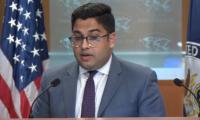LONDON: Mohammed bin Salman’s financial engineers are earning their fees. Plans for the Saudi crown prince to spearhead a triumphant listing of domestic oil titan Aramco are on ice, but his advisers have a workaround - Aramco may now create the cash itself by borrowing money and buying a stake in chemicals group SABIC. It’s a clever idea, but no substitute for plan A.
Looked at as a piece of corporate strategy, splicing together Aramco’s huge oil reserves with SABIC doesn’t automatically create much value. It makes more sense to see the leveraged acquisition as a way to replace the $100 billion that won’t materialize if Riyadh fails to list Aramco.
If the similarly state-owned Aramco buys the stake then the Public Investment Fund, earmarked as the engine for the crown prince’s Vision 2030 drive to diversify away from oil, would still have a chunk of cash for pursuits such as investing with Masayoshi Son’s Vision Fund.
Aramco can probably afford the move. It has minimal debt, Bloomberg reported on April 13, and made over $34 billion of net income in the first half of 2017.
With a probable value exceeding $1 trillion, bond markets and banks would be happy to provide it with the roughly $70 billion it would need to buy the 70 percent stake in SABIC.
And gearing up Aramco avoids many of the pitfalls of a listing: the state would not need to keep investors sweet with high dividends, and the crown prince can avoid the embarrassment of an IPO failing to reach the $2 trillion value he sought.
That’s all very well. But neither Aramco nor SABIC are as keen on the deal as the prince’s advisers, the Wall Street Journal reported on July 26.
If Riyadh were not wrestling with a large budget deficit, it’s hard to imagine it would be using its crown-jewel oil company to raise cash.
Even if the financial risks are low, the plan falls short of the ambition of the original Vision 2030 strategy.
The Aramco listing promised to diversify the state’s risk from petrodollars, while opening up Saudi equity capital markets. This is a funny way to do so.
Sheikh argued that the government should have maintained stable petroleum prices
MARI has successfully drilled and tested the third appraisal well in the Ghazij formation in the Mari D&PL
Gold rates decreased by $17 to $2,395 per ounce in the international market
Company's revenue saw a 13.9% year-on-year increase, reaching Rs49.2 billion, up from Rs43.19 billion in the same...
A man counts US dollars in a money exchange shop in Dhaka. — AFP/FileLAHORE: The first thing that the government...
Power generation stood at 8,741 gigawatt-hours or 11,749 megawatts in March







